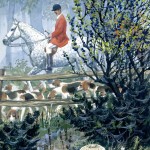In an earlier post I wrote about some of the strange coincidences that have emerged in the course of developing this exhibition. Another bizarre coincidence has now come to light. It is concerned not so much with a history relating to the written word or to visual culture but one that is nevertheless firmly centred on paper.
My colleague Helen Westhrop works as a Library Assistant in Special Collections and Cataloguing here at the University of Reading. In her spare time she is a keen blogger (her blog, Living Libraries and [Dead] Languages, is definitely worth following). Having been aware for some time that this exhibition was in progress and being interested in the Ladybird archive herself, Helen was trying to think of interesting ways of connecting her own writing with this collection. What she happened upon was a link between her own life story and the history of Ladybird books, possibly even connecting her with the physical manufacture of the Autumn volume at some stage in its later history.
Indeed, in the course of pondering ways to justify introducing discussion of the Ladybird collections she realised something rather amazing. At an earlier point in her career, Helen worked as a clerk in the Buying Office of John Dickinson Paper and Board, then based at Croxley Mills in Watford. One of this company’s most prominent customers was the publishing house Wills and Hepworth, producers of Ladybird books.
As Helen notes on her blog, she therefore at one time had a hand in the very production of these books, albeit from the source context of working for the company that produced the paper on which they were printed. Nevertheless, this surprising ‘paper trail’ and revealing ‘paper tale’ together provide yet more evidence of the fascinating stories that underpin this seemingly simple series of children’s books.
Far too often we take the material things in our lives for granted and give little thought to the highly complex processes involved in their production and distribution; the people and places, and the companies and cultures that lie behind the existence of artefacts like Ladybird books. Thanks are due to Helen for sharing her piece of this rich, detailed, and endlessly fascinating puzzle. Perhaps others might be persuaded to share their own part, however small, in the processes that brought subsequent editions of the huntsman image and the What to Look For books to the book shops and to our modern-day book shelves and bibliographic collections.














